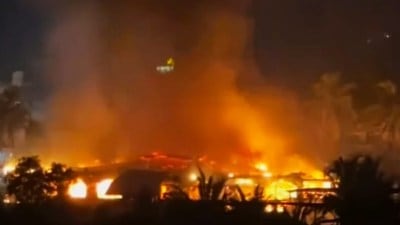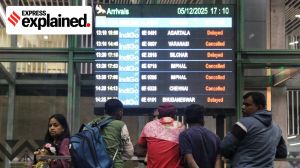The history of Iran’s nuclear programme
Iran’s pursuit of nuclear technology began in the early 1970s, fuelled by oil wealth and the Shah of Iran’s vision for industrial and technological advancement. After the Iranian Revolution of 1979, the programme saw shifts influenced by wars, global scrutiny and covert operations. From secret facilities and sanctions to the JCPOA, Iran’s nuclear journey remains a global flashpoint.
 Iran has been developing its nuclear program since the 1970s
Iran has been developing its nuclear program since the 1970s Iran’s Deputy Foreign Minister Majid Takht-Ravanchi is set to meet his European counterparts in Geneva on Friday (November 29) to discuss a potential revival of the 2015 nuclear deal. The meeting follows the collapse of an earlier proposal where Iran had offered to limit its uranium enrichment to 60 per cent purity — a level just short of what is required to produce nuclear weapons. Iranian officials described the offer as a preliminary step to rebuild confidence with the Western nations.
The talks will mark the end of a two-year gap in detailed negotiations over the lapsed Joint Comprehensive Plan of Action (JCPOA) agreement. While representatives from the EU, France, Germany, and the UK are slated to attend the meeting, China, Russia, and the United States will not be present.
Despite Tehran’s assurances that its nuclear programme is peaceful, the International Atomic Energy Agency (IAEA) has expressed significant concerns. Director General Rafael Mariano Grossi has cautioned that Iran possesses sufficient near-weapons-grade uranium to produce “several” nuclear bombs if it chose to proceed.
The situation first began to deteriorate in 2018 when Donald Trump decided to unilaterally withdraw from the agreement and reinstate harsh economic sanctions that severely impacted Iran’s economy. In response, Tehran began progressively scaling back its compliance with the deal.
Earlier this year, the US Secretary of State Antony Blinken warned that Iran’s “breakout time” or the duration required to produce sufficient fissile material for a nuclear weapon, has decreased to “probably one or two weeks”, the shortest timeframe ever publicly acknowledged by US officials.
Formation of Iran’s nuclear programme
Iran’s pursuit of nuclear technology began in the early 1970s, fuelled by oil wealth and the Shah of Iran’s vision for industrial and technological advancement.
According to a report by Sina Azodi published in 2021 by the Center for Strategic and International Studies (CSIS), an American think tank, the Shah’s government ratified the Treaty on the Non-Proliferation of Nuclear Weapons (NPT) in 1968 and started limited nuclear activities. However, his ambition was largely derailed by the Iranian Revolution of 1979, which forced the programme into dormancy.
The Iranian revolutionary government viewed nuclear technology as expensive and overly reliant on Western support. After the revolution, Fereydoun Sahabi, the first president of the Atomic Energy Organization of Iran (AEOI) ,noted that, “apart from technical difficulties, we are facing soaring costs which were never predicted when these agreements were first signed.”
Iran’s nuclear ambitions shifted dramatically once again around the halfway point of the Iran-Iraq war in the 1980s. As Azodi argues, the existential threats posed by Iraq’s chemical weapons and conventional military superiority led to reconsideration of the programme. Ayatollah Hashemi Rafsanjani, who served as the fourth president of Iran, later remarked, “When we first began, we were at war, and we sought to have that possibility for the day that the enemy might use a nuclear weapon. That was the thinking. But it never became real.”
In the 1990s, Iran significantly expanded its nuclear capabilities. Reports from the Stimson Center, a foreign policy think tank, show that Iran engaged with China in 1990 to secure nuclear cooperation and signed an agreement with Russia in 1995 to complete the Bushehr reactor, the Middle East’s first nuclear power plant. Like the Shah, the Islamic Republic also sent Iranian engineers abroad for advanced training in nuclear technology, ensuring the programme’s continuity.
According to Iran Watch, a portal to track developments in the region, created by the Wisconsin Project on Nuclear Arms Control, in the late 1990s, senior Iranian officials approved a plan, called the Amad Plan, to build an arsenal of five nuclear weapons by 2004.
In 2002, the National Council of Resistance of Iran revealed the existence of two nuclear facilities: a uranium enrichment site at Natanz and a heavy-water production facility at Arak. Iran Watch emphasises that while these facilities had potential civilian uses, they also had military applications. Natanz could produce weapons-grade uranium, and Arak could generate plutonium. Their concealment from the IAEA heightened suspicions about Iran’s nuclear ambitions.
The Amad Plan
Several pivotal events in the early 2000s reshaped Iran’s nuclear trajectory. The terrorist attacks of September 11, 2001 and the subsequent US invasion of Iraq removed a key regional threat to Iran. According to Azodi, revelations about Iran’s secret underground enrichment facility at Natanz amplified international scrutiny.
The George W Bush administration’s adoption of a ‘freedom agenda’ and its ‘pre-emptive war’ doctrine, combined with overt regime change threats, added significant pressure. This atmosphere likely led Iran to reassess its nuclear strategy, as Tehran feared the programme could serve as a pretext for a US invasion. In 2003, Iran formally halted the Amad Plan.
However, as Iran Watch notes, the cessation of the Amad Plan did not signify an end to all weaponisation-related activities. Instead, Iran divided its nuclear efforts into overt and covert streams. The overt programme included facilities like Natanz and the Arak heavy-water plant, while covert research continued on sensitive technologies, including computer modelling for implosion and yield calculations.
In 2003, Iran also suspended enrichment activities and signed an additional protocol with the IAEA under a deal brokered by the EU-3 (France, Germany, and the UK). Despite these commitments, Iran’s disclosures to the IAEA in 2004 and 2005 were incomplete, prompting concerns over the programme’s transparency. By 2006, Iran announced it had enriched uranium to 3.6 per cent, escalating tensions further. These developments led the P5+1 (China, France, Russia, the UK, and the US, and Germany) to propose a framework for halting Iran’s enrichment, but the diplomatic impasse deepened, resulting in UN sanctions and growing international isolation.
Obama and the Iran deal
Barack Obama’s presidency marked a shift toward multilateral engagement on Iran’s nuclear programme. Negotiations resumed in 2009, initially focusing on a fuel swap arrangement, which Iran ultimately rejected. As Sanam Vakil highlights in a 2020 report for Chatham House, efforts by Turkey and Brazil to broker a similar deal in 2010 also failed. That same year, the UN Security Council passed Resolution 1929, imposing stringent sanctions on Iran’s energy and financial sectors. Throughout this period, Tehran insisted on its right to enrich uranium, a sticking point that hindered progress in talks.
In 2012, a backchannel was established between the US and Iran, complementing the wider P5+1 discussions. The Obama administration proposed a framework for limited domestic enrichment in exchange for long-term restrictions on Iran’s nuclear programme and robust monitoring mechanisms. This change in US policy, combined with the election of moderate President Hassan Rouhani in 2013, revitalised negotiations. By 2015, these efforts culminated in the Joint Comprehensive Plan of Action (JCPOA), adopted unanimously by the UN Security Council.
The JCPOA aimed to extend Iran’s breakout time through rigorous monitoring provisions, including unprecedented IAEA access. Iran dismantled two-thirds of its centrifuges, shipped out 97 per cent of its enriched uranium stockpile, and agreed to redesign the Arak reactor to prevent plutonium production. Implementation Day on January 16, 2016, marked the lifting of nuclear-related sanctions following Iran’s compliance with the deal’s terms.
Despite its achievements, the JCPOA faced criticism. Regional players like Israel and Saudi Arabia argued that the deal failed to address Iran’s ballistic missile programme and support for proxy groups. Conservatives in Iran, meanwhile, feared the agreement compromised national sovereignty. Trump, described the JCPOA as “the worst deal ever” which could lead to “a nuclear holocaust.”
Nevertheless, the JCPOA received cautious approval from Supreme Leader Ali Khamenei and Iran’s parliament.
Back and Forth
Under the Trump administration, the United States withdrew from the JCPOA on May 8, 2018. The decision sparked widespread international criticism. In a joint statement, the leaders of France, Germany, and the United Kingdom reaffirmed their commitment to the JCPOA, stating that the UN Security Council resolution endorsing the deal remained a “binding international legal framework for the resolution of the dispute.”
According to the Center for Arms Control and Non-Proliferation, the Trump administration’s policy of “maximum pressure” included re-imposing severe sanctions on Iran and threatening financial isolation for allies who failed to comply. These actions antagonised key allies and squandered opportunities to pursue renegotiations addressing concerns about the original deal.
From 2018 to 2020, Iran resumed enrichment activities, restarted research on advanced centrifuges, and expanded its stockpile of nuclear material, cutting its breakout time in half. By the end of Trump’s term, Iran’s nuclear programme had significantly advanced, and the country had adapted to sanctions by stabilising its economy, albeit at great cost to its citizens. Iran also escalated its retaliatory actions against US interests in the region, complicating America’s regime-change aspirations.
Joe Biden’s election promised a potential reset. Biden’s administration expressed a willingness to re-engage with Iran on nuclear diplomacy if Tehran complied with JCPOA protocols. However, as academic Jane Darby Menton notes in Foreign Policy, confidence in US commitments had been severely undermined by Trump’s withdrawal. The election of Iran’s hardline president, the late Ebrahim Raisi in 2021 further complicated negotiations, as the new administration adopted a more sceptical stance toward diplomacy with the West. Meanwhile, consensus among the JCPOA’s original signatories eroded, and Iran strengthened alliances with autocratic regimes like Russia.
What’s next?
The path forward for addressing Iran’s nuclear programme remains fraught with uncertainty. According to Menton, “In the past five years, the prospects of peacefully resolving the Iran nuclear crisis have gone from bad to worse. Tehran is once again on the precipice of breakout, and addressing proliferation concerns through diplomacy has only gotten harder.”
She attributes this deterioration not only to technical hurdles but also to shifting political dynamics.
The conflict in Gaza has escalated tensions between Israel and Iran, culminating in an Israeli airstrike on an Iranian nuclear facility in Parchin in October 2024. While Biden has expressed his opposition to such pre-emptive strikes on nuclear facilities, the dynamics are expected to shift with the return of President-elect Trump. During his campaign, Trump urged Israel to “hit the nuclear first and worry about the rest later,” signalling a more aggressive stance toward Iran under his upcoming administration.
However, experts suggest this approach may face significant obstacles. As a number of Brookings Institution analysts point out in a 2024 report, the effectiveness of Trump’s previous sanctions strategy relied heavily on international compliance, particularly from China – support that has since waned.
Moreover, key regional players like Saudi Arabia have shifted strategies, favouring engagement with Tehran over confrontation. These shifting geopolitical alignments may blunt the impact of renewed US efforts to isolate Iran economically and diplomatically .
Amid these mounting crises, the likelihood of Iran restricting its nuclear programme as a bargaining tool appears increasingly slim. As the landscape grows more volatile, the prospects for a diplomatic resolution seem dimmer than ever.
- 01
- 02
- 03
- 04
- 05































